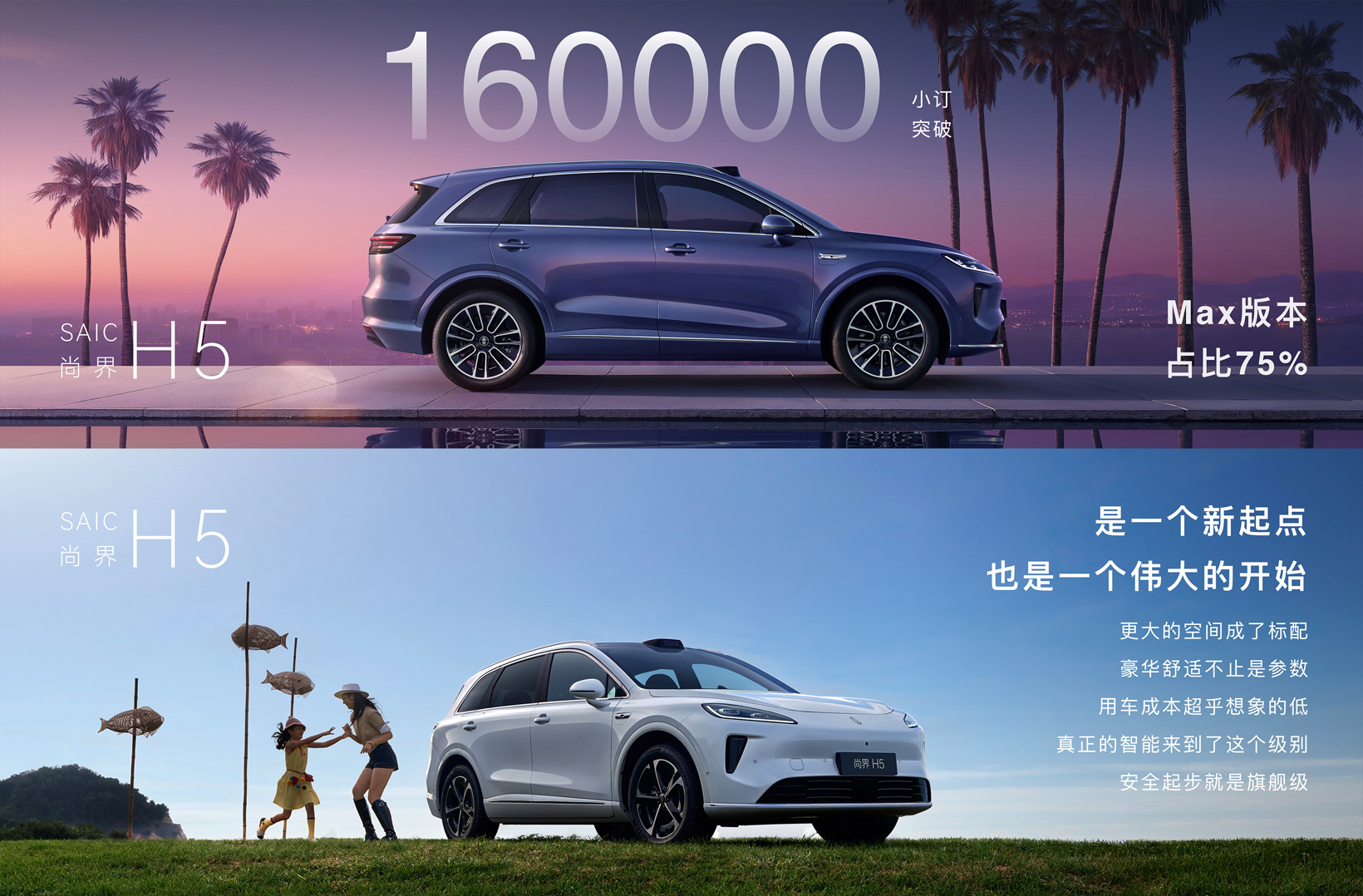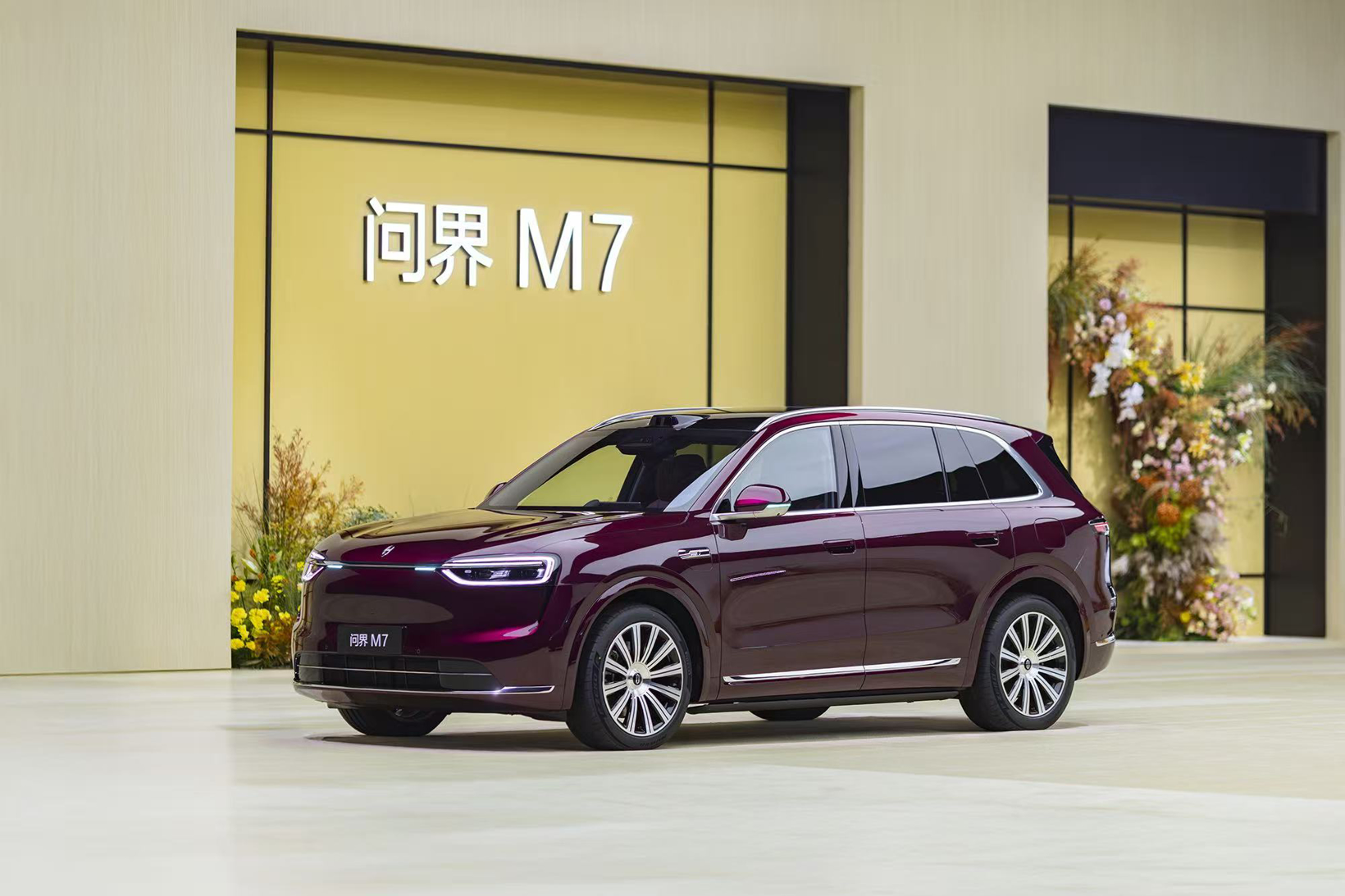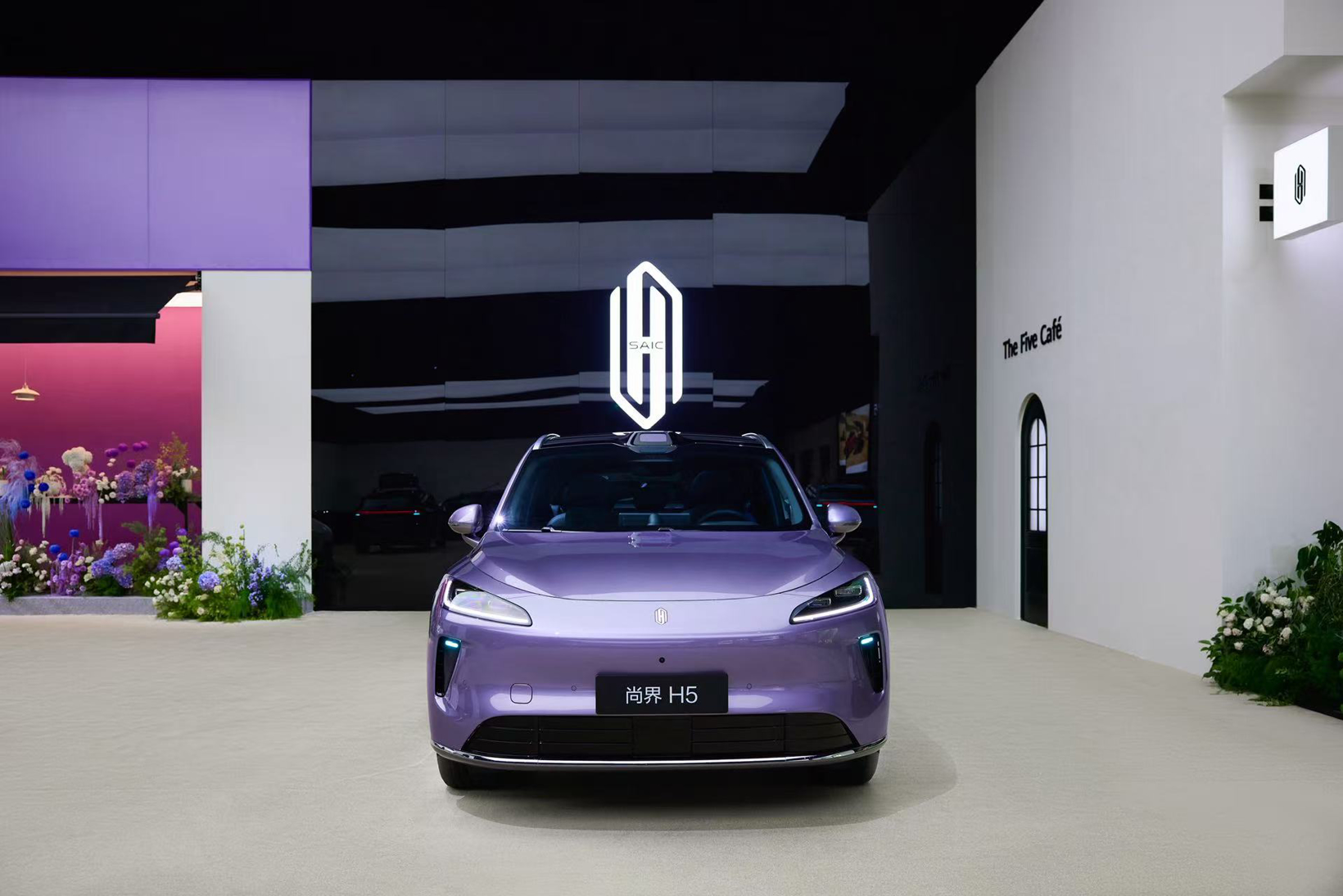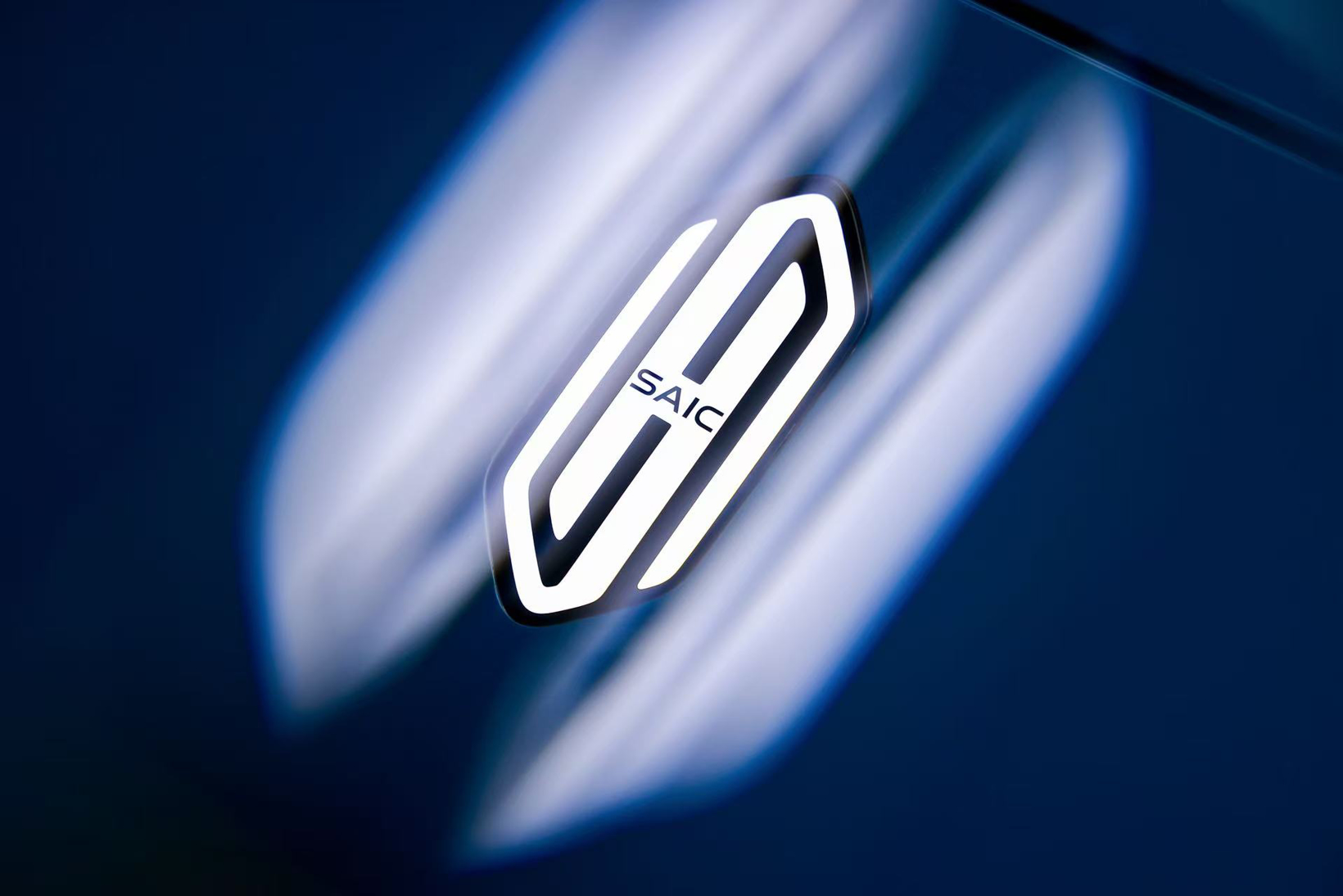15 Million Market, Looking to Establish a "New King"?
The market at the 150,000 level ultimately entered the Huawei system.
"Huawei wants to make this event a grand affair," said the driver who was picking up guests for the HarmonyOS Smart Travel Autumn New Product Launch. "I guess there are over a hundred business vehicles responsible for transportation."
It can be said that the Shangjie H5, known as the "most affordable" car in the Huawei family, actually enjoys an ultra-luxurious "treatment."
Before this, the Huawei series did not sell "cheap" cars.
In 2023, the "resurrection" of the AITO M7 demonstrated the "Huawei speed" to the industry; in 2024, the continued hot sales of the Zhijie S7 and AITO M9 further established the market position of HarmonyOS Intelligent Vehicles.
As more and more brands focus on high-end models, Huawei's HarmonyOS Intelligent Driving Alliance unexpectedly places its next strategic move in the fiercely competitive and turbulent high ground of the 150,000 RMB mid-size SUV market.
What significance does theH5 have for the 150,000-level market and Huawei?
Starting at 159,800 yuan, is the Huawei-affiliated cheapest model "cost-effective"?
The Shangjie H5 has been in the spotlight for quite some time. Since its preparation began last year until its launch on September 23, the Shangjie H5 has indeed surprised the market.
First is the price.
On August 25th, Yu Chengdong announced that the pre-sale price of the Shangjie H5 would start at 169,800 yuan. At that time, this price already surprised the market, and competitors also felt a bit anxious.
Yu Chengdong described the car's price as "stunning." Subsequently, within one hour of the new car going on sale, orders exceeded 25,000 units. On August 26, Shangjie Auto announced that its H5 model pre-sold over 50,000 units in 18 hours.
On September 8th, Shangjie Auto announced that the small order volume for Shangjie H5 had successfully exceeded 80,000 units, with pre-sale performance remaining outstanding. On September 22nd, Shangjie Auto stated that since the start of the pre-sale, the cumulative number of small orders for the Shangjie H5 had surpassed 150,000 units, reaching 151,036 units.
Not yet officially launched, the pre-sale orders for the Shangjie H5 have already exceeded 150,000 units, demonstrating significant market confidence in Huawei's brand of vehicles. Behind this, more importantly, many people are curious to see how Hongmeng Zhixing, which is accustomed to making high-end models, will adapt to creating vehicles priced below 200,000 yuan. What kind of surprises will this bring?
On September 23rd, the Shangjie H5 was officially launched amidst much anticipation. The price ranges from 159,800 to 199,800 yuan, which is exactly 10,000 yuan less than the previously announced pre-sale price of 169,800 yuan. At the same time, the Shangjie H5 also offers car purchase benefits of up to 43,788 yuan.
On the same day, Hongmeng Smart Mobility announced that since the launch of the Xiaoding on August 25, the Shangjie H5 Xiaoding has surpassed 160,000 units, with over 75% being the top configuration model.
The "cheapest" model of Hongmeng Smart Mobility has become a topic of competition among major media outlets.

Image Source: HarmonyOS Smart Travel
For a new car entering the market, the two most important strategic dimensions are price and features.
It can be said that Shangjie H5 has chosen the right price range in its pricing.
In terms of configuration, the Shangjie H5 is positioned as a mid-sized SUV, with dimensions of 4780×1910×1664 millimeters and a wheelbase of 2840 millimeters.
In terms of power, the Shangjie H5 offers two options: pure electric and range-extended. The pure electric version is equipped with a rear single motor, available in two versions with total electric motor power of 150kW and 180kW. Depending on the configuration, it is paired with a 64.6kWh lithium iron phosphate battery or an 80kWh ternary lithium battery, with CLTC pure electric ranges of 525km, 535km, 640km, and 655km. The range-extended version is equipped with an SAIC DMH 1.5L engine specifically for range extension, with a battery capacity of 32.6kWh and a CLTC pure electric range of 235km.
Of course, as a Huawei-affiliated model, what the market anticipates most about the Shangjie H5 is its intelligent configuration.
Indeed, it lives up to expectations. The Shangjie H5 has brought Huawei's high-level intelligent driving assistance system down to the market below 200,000 yuan. It comes standard with the Huawei Qiankun Intelligent Driving ADS 4 system, equipped with a luxurious hardware combination of a 192-line LiDAR (detection range of 250 meters) and three 4D millimeter-wave radars. While driving, it can cover all scenarios including highways, urban roads, and rural roads, claiming to be the "only end-to-end navigation assistance in its class," with forward, rearward, and lateral collision avoidance.
The Shangjie H5 vehicle is developed based on the SAIC Roewe ES39 model, equipped with Huawei's intelligent cockpit and intelligent driving system. It is built on SAIC's Nebula pure electric platform and comes standard with the HarmonyOS cockpit. Through features like Super Desktop and cross-device connectivity, it enables seamless flow of mobile applications. Entertainment features such as No Mic Karaoke 2.0 and HUAWEI MagLink screen projection further enrich the in-car experience.
The biggest highlight of the Shangjie H5 is that for just 150,000 yuan, you can enjoy the Huawei ADS 4 advanced driver-assistance systems as standard across all models, along with the intelligent experience brought by the HarmonyOS cabin.
In April this year, Huawei QianKun became the first among leading intelligent driving suppliers to release the QianKun Intelligent Driving ADS 4 system based on a world model, marking a new phase in advanced driver assistance systems. In September this year, Huawei QianKun Intelligent Driving ADS 4 will gradually be installed in vehicles.
The system incorporates the WEWA architecture, utilizing high-precision solid-state LiDAR, in-cabin laser vision sensors, and distributed millimeter-wave radar. It is equipped with the XMC digital chassis engine and CAS 4.0 all-dimensional collision avoidance system. The flagship version of ADS Ultra supports the commercialization of L3-level autonomous driving capabilities on highways.
According to a research report by Dongfang Securities, as the first model priced under 200,000 yuan equipped with Huawei's ADS 4 advanced driver-assistance system, the Shangjie H5 is expected to attract considerable market attention and offer outstanding value for money.
How can the so-called "cost-performance ratio" be specifically quantified?
In comparison, the Huawei ADS 4 assisted driving system is equipped on the Lantu FREE model, and subsequently applied to models like the MENGSHI M817. Additionally, the entire series of AITO has entered the era of the Huawei ADS 4 assisted driving system, with the AITO M8 pure electric version being delivered with the Huawei ADS 4 assisted driving system. On September 20, the 2026 Avatr 07 was officially launched, being the first to be equipped with the Huawei QianKun ADS 4, and features the HarmonySpace 5 HarmonyOS cockpit, QianKun All-Dimensional Collision Avoidance CAS 4.0, among others.
On the same day that the Shangjie H5 was launched, the entire Zhijie lineup began OTA upgrade pushes. At that time, the entire Zhijie lineup will be upgraded to the Huawei ADS 4 assisted driving system.
Considering the price range of the models equipped with the Huawei ADS 4 assisted driving system, the cost-effectiveness of the assisted driving configuration of the Shangjie H5 is evident.
However, on the other hand, simply comparing from the dimension of vehicles equipped with Huawei's intelligent driving products does not have 100% persuasive power.
After all, "comparing yourself to yourself" will never clearly distinguish between good and bad.
Using smart pricing space, the 150,000-level market is undergoing transformation?
Whether Shangjie H5 can withstand the test still needs to be verified in the market.
After the release of the Shangjie H5, the "Five Realms Gathering Strength" pattern of HarmonyOS Intelligent Mobility has basically taken shape. The intelligent automotive brands Wanjie, Xiangjie, Zunjie, Zhijie, and Shangjie, developed in cooperation with Seres, BAIC, JAC, Chery, and SAIC respectively, mark the comprehensive expansion stage of Huawei's intelligent automotive solutions.
AITO focuses on the SUV market, Xiangjie is positioned as a luxury sedan, Zunjie targets the high-end business segment, and Zhijie focuses on the younger demographic. Meanwhile, Shangjie is tasked with penetrating the mainstream household market and achieving a breakthrough in sales scale. To accomplish this goal, the Shangjie H5 must stand out in the fiercely competitive 150,000 yuan mid-size SUV market.
According to the cumulative sales data of mid-size SUVs released by the China Automobile Data Research Institute for January to July 2025, the cumulative retail sales of passenger vehicles in the domestic market reached 12.74 million units from January to July this year, an increase of 10.2% year-on-year. Among them, the cumulative sales of mid-size SUVs amounted to 1.952 million units, with a year-on-year growth of 11.9%.
In the cumulative sales of mid-sized SUVs from January to July, the top ten are: Tesla Model Y (202,257 units), Volkswagen Tiguan L (107,730 units), Chery Tiggo 8 (104,511 units), Volkswagen Tayron (95,121 units), BYD Song L DM-i (84,827 units), Mercedes-Benz GLC (77,699 units), Audi Q5L (75,806 units), Buick Envision Plus (71,762 units), Leap Motor C10 (66,797 units), and Jietu X70 (62,158 units).
In the TOP10 of this list, fuel vehicles occupy 7 spots, while new energy vehicles account for 3 spots. However, looking at the entire TOP100 list, new energy vehicle brands are everywhere, including BYD, Leapmotor, Deepal, Letin, Zeekr, NIO, XPeng, Avatr, and so on.
The competitive logic of this market has evolved from the early "range comparison" to a "comprehensive strength competition." Brands like BYD, Xiaopeng, and Leap Motor have occupied a significant market share thanks to their first-mover advantage, and the entry of the Shangjie H5 is bound to face intense competition.

Image source: HarmonyOS Intelligent Travel
In order for Shangjie H5 to capture a considerable market share, it must directly confront the aforementioned models, especially BYD.
From January to July this year, the sales of BYD Song L DM-i surged by 5702.1% year-on-year, making it the fastest-growing model on the list.
The BYD Song L DM-i is equipped with the fifth-generation DM hybrid system, featuring a 1.5-liter engine (maximum power of 74 kW) and a drive motor (maximum power of 160 kW). It offers battery packs of 18.316/26.593 kWh, with WLTC conditions for pure electric range of 112 km and 160 km, and a fuel consumption of 4.95-4.98 liters per 100 km when the battery is depleted.
In July last year, the BYD Song L DM-i was officially launched with a starting price of 135,800 yuan, and its sales exceeded 10,000 units in the first week. In February this year, a smart driving version was introduced, with a price range of 135,800 to 175,800 yuan. In March of the same year, the starting price of the non-smart driving version was reduced to 119,800 yuan. The new car is built on a new generation plug-in hybrid platform and comes standard with 7 airbags, the DiPilot smart driving assistance system (including L2 level driving assistance functions), and is equipped with the DiLink 100 intelligent cockpit and a 15.6-inch adaptive rotating floating screen.
In the new energy mid-size SUV market, BYD has a wide range of models. On July 24, BYD's Ocean Network launched the all-new mid-size SUV Haima 06, with the official guide price for the Haima 06 DM-i ranging from 139,800 to 156,800 yuan, and the official guide price for the Haima 06 EV ranging from 143,800 to 163,800 yuan.
The Sea Lion 06DM-i is equipped with BYD's fifth-generation DM technology, with an NEDC condition fuel consumption of only 3.5 liters per 100 kilometers when running low on electricity, and a combined range of 1670 kilometers with full fuel and full charge. The Sea Lion 06EV is built on the e-platform 3.0 Evo and offers two range versions of 520 kilometers and 605 kilometers. The entire Sea Lion 06 series comes standard with the "Eye of God" C - Intelligent Assisted Driving Three-Eye Version (DiPilot 100), supporting high-speed pilot assistance and all-scenario intelligent parking assistance functions.
Currently, both BYD Song L DM-i and Hai Si 06 are priced significantly lower than Shangjie H5. Their core advantages lie in BYD's mature powertrain system and brand appeal, but their intelligent driving capabilities remain at a basic assistive level. The ecological advantages of HarmonyOS cockpit may offer a competitive edge against them.
Apart from BYD, Leapmotor is also an important competitor that cannot be ignored in the industry.
The pre-sale price range for the Leapmotor C10 range-extended model is from 151,800 to 181,800 yuan, and for the all-electric model, it is from 155,800 to 185,800 yuan. The price range is almost the same as that of the Shangjie H5, virtually putting them in direct competition.
In terms of configuration, the Leap C10 is built on the "Four-Leaf Clover" central integrated electronic and electrical architecture, equipped with LiDAR, and also supports advanced assisted driving functions. In addition, the Leap C10 is powered by the Qualcomm 8295 smart cockpit chip and top-tier intelligent driving hardware, including a 128-thread LiDAR and NVIDIA Orin-X smart driving chip.
On August 18, Leapmotor announced that the Leapmotor C10 had achieved cumulative deliveries of 150,000 units over 16 months since its launch.
In July this year, the all-new Leapmotor C11 was launched with a suggested retail price of 149,800 to 165,800 RMB. The all-electric model is equipped with a large 81.9kWh battery, with a CLTC range increased to 640km. It comes standard with a full-domain 800V high-voltage silicon carbide fast-charging platform, with the fastest charging time from 30% to 80% SOC taking only 18 minutes, and a power consumption as low as 14.4kWh per 100 kilometers.
In terms of assisted driving, the all-new C11 is equipped with 28 intelligent sensing hardware and the Qualcomm 8650 chip combination, capable of achieving 27 assisted driving functions such as highway navigation assistance, commuting navigation assistance, and parking assistance. It also features end-to-end large model assisted driving, integrating previously independent modules such as perception, prediction, and planning, with the potential to upgrade to "parking space to parking space" assisted driving functionality in the future.
The Leapmotor C11 has sold over 250,000 units in the four years since its launch.
In July this year, the Deep Blue Auto S07 was also launched with a guide price of 149,900 to 212,900 yuan. This car is equipped with the Qualcomm Snapdragon 8155 chip and uses the Shenxing 3C supercharged battery.
Notably, the Deep Blue S07 is equipped with Huawei's Qian Kun Intelligent Driving ADS SE, supporting highway navigation assistance and intelligent parking assistance.
Whether the Shangjie H5 can shoulder the responsibility of "volume sales" depends on its differentiated competition with rivals like BYD and Leapmotor. More importantly, it hinges on its ability to convert the presale enthusiasm of 160,000 units into a sustained market reputation through deliveries.

Image Source: HarmonyOS Intelligent Travel
From the perspective of the competitive landscape, this model, which carries the mission of scaling HarmonyOS Intelligent Driving, is facing a three-dimensional challenge on three fronts, yet holds the core leverage to break the deadlock.
In the face of BYD's "price encirclement," Shangjie H5 constructs defensive works through "technological elevation." The starting price of Song L DM-i at 119,800 yuan and the fuel consumption of 3.5L in the Haiqi 06 DM-i precisely address the range anxiety and cost concerns of budget-sensitive users. BYD's years of accumulated reputation in the three electric systems and its brand appeal are formidable moats that are difficult to shake in the short term.
The breakthrough point of Dan Shangjie H5 lies in the "intelligent generation gap": the combination of 192-line LiDAR and Huawei ADS 4 system brings advanced functions such as urban NCA and omnidirectional collision avoidance into the market within 200,000 yuan, reaching a level that BYD models equipped only with basic L2 assistance cannot match. The super desktop function of the HarmonyOS cockpit achieves seamless integration with the mobile phone and PC ecosystem, offering scenario-based experiences like browsing Douyin and video conferencing, which are more in line with the needs of young users compared to the traditional interaction of DiLink 100.
The logic of "exchanging intelligence for price space" precisely attracts family users willing to pay a premium for an upgraded experience—75% of Max version orders confirm the authenticity of this demand.
In the "close combat" with Leapmotor, the advantages of Shangjie H5 lie in its "ecological closed-loop" and "technological maturity." Leapmotor C10 and C11, with similar price ranges and hardware such as Qualcomm 8295 and NVIDIA Orin-X, build an ostensibly powerful configuration list. The cumulative sales of 250,000 units also prove its market acceptance.
The core competitiveness of the Shangjie H5 is not just its single hardware, but rather the algorithm capabilities of Huawei ADS 4, which have been validated by millions of vehicles. More importantly, the synergistic effect of the HarmonyOS ecosystem: the Shangjie H5 has achieved cross-device integration between the car, mobile phones, and PCs. This ability to iterate experiences that are "commonly used and always new" is a barrier that vertical car manufacturers find difficult to replicate.
Focusing on the Deep Blue S07 equipped with Huawei's QianKun intelligent driving ADS SE, it only supports high-speed navigation driving capabilities, which represents a technological gap compared to the all-scenario coverage of the Shangjie H5's ADS 4. It mainly caters to users who have a favorable view of Huawei's technology but have a limited budget.
In the entire 150,000 to 200,000 RMB mid-size SUV market, the key for Shangjie H5 to achieve high sales volume is to accurately seize the moment when the market shifts from "range competition" to "comprehensive strength competition."
The fact that fuel vehicles still occupy 7 seats in the TOP 10 list indicates that the mainstream market has not yet fully completed the comprehensive penetration of intelligent upgrades. The Shangjie H5, labeled as the "only high-level intelligent driving model with laser radar in the 150,000 yuan range," provides fuel vehicle users with a clear reason to switch.
Of course, challenges have never disappeared: BYD may accelerate the rollout of advanced intelligent driving, Leap Motor may squeeze the space through a price war, and the actual implementation effects of intelligent driving functions and the long-term service quality still need to be tested in the market after large-scale deliveries.
At least for now, Shangjie H5 has carved out a niche in the competitive market with its precise positioning of "Intelligent Driving Equality". If it can continuously optimize the experience through OTA updates, transforming pre-sale hype into word-of-mouth promotion, this HarmonyOS-powered "price spearhead" will not only fulfill its mission of achieving sales volume but also drive the entire market from "hardware competition" to a new stage of "ecosystem competition".
H5 acts as a "signboard," is Huawei trying to be the "catfish" that rewrites the rules?
The launch of the ShangJie H5 is not only a landmark event in Huawei's technological penetration but also a phased achievement of deep cooperation between Huawei and SAIC.
The marriage between "tech giants and automotive groups" brings practical benefits to both sides and provides a new model for industry collaboration. The proactive alignment of automakers such as GAC and Dongfeng indicates that Huawei's smart driving ecosystem is entering a phase of accelerated expansion.

Image Source: HarmonyOS Intelligent Travel
On September 23, the day of the official launch of the Shangjie H5, according to the "Dongfeng Motor" WeChat official account, on the 22nd, Dongfeng Motor Chairman and Party Secretary Yang Qing visited Shenzhen for discussions with Huawei's founder Ren Zhengfei and Huawei's rotating chairman Xu Zhijun. The two sides engaged in in-depth exchanges on topics such as strengthening strategic mutual trust, deepening strategic cooperation, and promoting innovation in corporate governance and operational mechanisms.
According to reports, Yang Qing stated that Dongfeng Motor is actively promoting the transition to new energy and intelligent technology, and will continue to deepen strategic collaboration with Huawei to jointly face industrial transformations and market challenges.
In addition, recently, GAC Group and Huawei jointly announced the birth of a new high-end intelligent new energy vehicle brand "Qijing," marking a phase of advancement in their cooperation.
According to the plan, the Qijing brand will focus on the high-end smart new energy market, with its first model scheduled to be launched in 2026. It will cover both pure electric and range-extended dual power routes and will be equipped with Huawei's QianKun intelligent driving, intelligent cockpit, and other core technologies across the entire lineup. This cooperation is not only a key arrangement for GAC Group under the "Panyu Action" reform but is also regarded as another significant exploration of Huawei's business model in the automotive sector.
The market popularity and sales performance of Shangjie H5 will determine whether Hongmeng Zhixing can further strengthen the confidence of other car manufacturers in collaborating with Huawei.
Dongfeng and GAC's proactive alignment reflects the trend of industry development.
For most traditional car manufacturers, developing advanced autonomous driving systems independently faces the challenges of "high investment, long cycle, and high risk," making collaboration with Huawei an effective path to achieve "leapfrog development."
Huawei's advantages lie not only in its technological leadership but also in the scenario data advantages accumulated through multi-brand collaborations. As the number of models equipped with Huawei's intelligent driving system increases, the system's learning and adaptation capabilities will continue to improve, forming a positive cycle of "more data - better experience - higher sales."
From Huawei's cooperation strategy perspective, it is building an intelligent driving ecosystem through a "diversified model + layered coverage." This multi-level cooperation system allows Huawei to maintain technological leadership while achieving large-scale implementation, avoiding the limitations of a single cooperation model.
For the industry, the intensive collaboration between Huawei and car manufacturers is accelerating the popularization of smart vehicles. Before 2023, advanced intelligent driving was considered an "exclusive feature" for models priced above 300,000 yuan; in 2024, the Shangjie H5 will lower this threshold to the 150,000 yuan level. Following this trend, in the next 1-2 years, models priced around 100,000 yuan are expected to be equipped with a basic version of the advanced intelligent driving system.
Currently, the storm initiated by Shangjie H5 is reshaping the competitive landscape of the 150,000-level market and rewriting the trajectory of smart vehicle development in China.
The story of Shangjie H5 may just be the prelude to Huawei's intelligent automotive ecosystem expansion.
【Copyright and Disclaimer】The above information is collected and organized by PlastMatch. The copyright belongs to the original author. This article is reprinted for the purpose of providing more information, and it does not imply that PlastMatch endorses the views expressed in the article or guarantees its accuracy. If there are any errors in the source attribution or if your legitimate rights have been infringed, please contact us, and we will promptly correct or remove the content. If other media, websites, or individuals use the aforementioned content, they must clearly indicate the original source and origin of the work and assume legal responsibility on their own.
Most Popular
-

Zf asia-pacific innovation day: Multiple Cutting-Edge Technologies Launch, Leading Intelligent Electric Mobility
-

Mexico officially imposes tariffs on 1,400 chinese products, with rates up to 50%
-

Fire at Sinopec Quanzhou Petrochemical Company: 7 Injured
-

List Released! Mexico Announces 50% Tariff On 1,371 China Product Categories
-

Argentina Terminates Anti-Dumping Duties on Chinese PVC Profiles! Kingfa Technology & Siemens Sign Digital and Low-Carbon Cooperation Agreement






